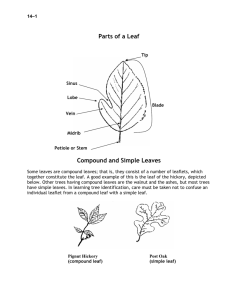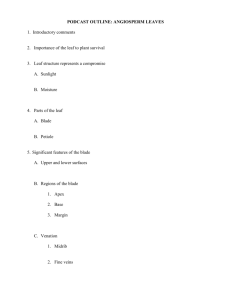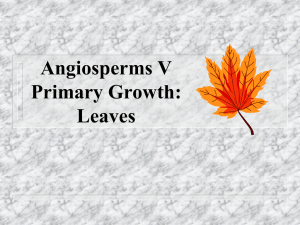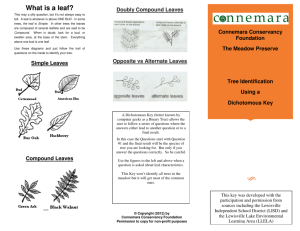Leaves
advertisement
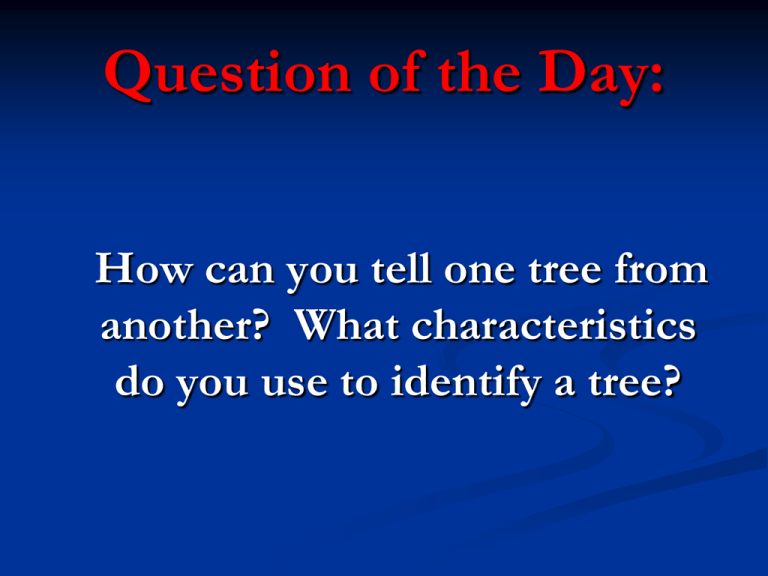
Question of the Day: How can you tell one tree from another? What characteristics do you use to identify a tree? Dendrology What is dendrology? Dendrology is the scientific study of trees and other woody plants. Trees vs. Shrubs Tree = one, main woody stem Shrub = small, woody, branched from base 2 Major Tree Divisions Deciduous aka: Hardwoods & Broadleaf Sheds leaves seasonally Broad leaves Hardwood Examples: Oaks, Maples, Tulip Poplars, etc. Conifers aka: Softwoods & Evergreen Bear cones Needle or scale-like leaves Softwood Examples: Pines, Cedars, Firs, etc. Tree Identification Trees may be identified by various means including: Leaves Bark Tree Shape Flowers and Fruit Etc. Let’s focus on leaves Leaves Leaves are often the easiest/best way to identify a tree. Needles and scale of evergreens are also considered leaves. Some questions to consider when identifying leaves: Simple or compound? Margins smooth or rough? Arrangement on twig opposite or alternate? Veins pinnate (like a feather) or palmate? Leaf Parts Important Vocab: Blade = whole leaf Petiole = stem Margin = outer edge Leaves– Simple or Compound Simple leaves only have one leaf blade. Compound leaves are made up of several separate leaflets attached to a common leaf stem. Simple Source: Ohio State University– Biology of Horticulture Website Compound Leaves Important to remember: Compound leaves have leaflets which are attached to the leaf stalk (not the twig) Leaflets can be attached to the leaf stalk in several ways: Pinnately Compound Bipinnately Compound Palmately Compound Compound Leaves (Cont.) Pinnately Compound The leaflets are attached across from each other Resembles a “feather” Ex: White Ash P I N N A T E Source: Ohio State University– Biology of Horticulture Website Compound Leaves (Cont.) Bipinnately or Twice Compound The primary leaflets are divided into secondary leaflets, also written 2-pinnate Ex: Honeylocust Bipinnate Source: Ohio State University– Biology of Horticulture Website Compound Leaves (Cont.) Palmately Compound The leaflets are arranged in a pattern that looks like fingers on the palm of a hand Ex: Horse Chestnut P A L M A T E Source: Ohio State University– Biology of Horticulture Website Quick Check for Understanding: Simple? Compound? Leaves– How arranged on twig? (Leaf Arrangement) Opposite Alternate When leaves are arranged directly across from each other on the twig. When leaves stagger up the twig and are NOT located directly across from each other. Whorled 2 or 3 leaves attached at the same point on the twig and “whorl” around the twig (think of circle) Leaf Arrangement (Continued) Alternate Whorled Opposite Leaf Arrangement (Cont.) Most trees have alternate branching. Think to yourself “MAD Horse” (Maple, Ash, Dogwood, and Horse Chestnut) to remember those with opposite branching. Leaf Arrangement (Continued) It is important to remember… The opposite vs. alternate vs. whorled arrangement refers to the way the LEAVES are arranged on TWIG, not the way the leaflets are arranged on the leaf stalk. Quick Check for Understanding: Alternate? Opposite? Whorled? A B C Leaves– Margins The margin of the leaf is the leaf edge. 3 major types: Entire Margin Lobed Margin Toothed Margin Leaves– Margins (Cont.) Entire Margin = smooth edges Ex: Eastern Redbud Leaves– Margins (Cont.) Lobed margin = projections that shape the edge of the leaf Ex: White Oak Leaves– Margins (Cont.) Toothed Margin = saw-like edge on the leaf Serrated edge Example: Sycamore Leaves– Veins Pinnately veined means that there is only one main vein. Palmately veined means that there are several main veins originating from the petiole. Leaves– Veins (Cont.) Pinnate Veins (Ex: Dogwood) Leaves– Veins (Cont.) Palmate Veins (Ex: Sweetgum) Conifers Conifers bear cones and have needles. Needles can be single & flat, blunt, round or sharp. Spruce needles are sharp and individually attached to the stem. Needles can be grouped together in tufts or bundles. Pine needles are attached to twig in “bundles” of 3-5, depending on species
